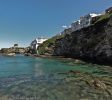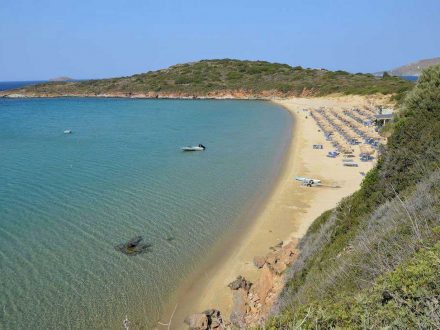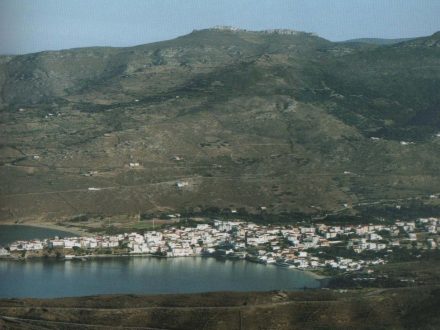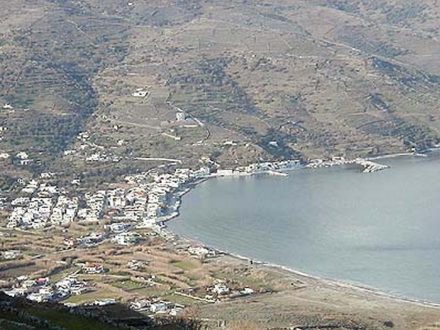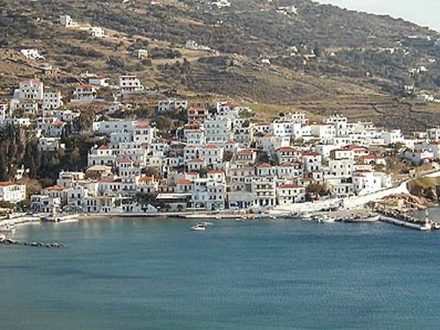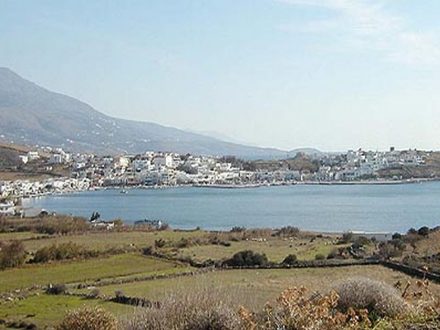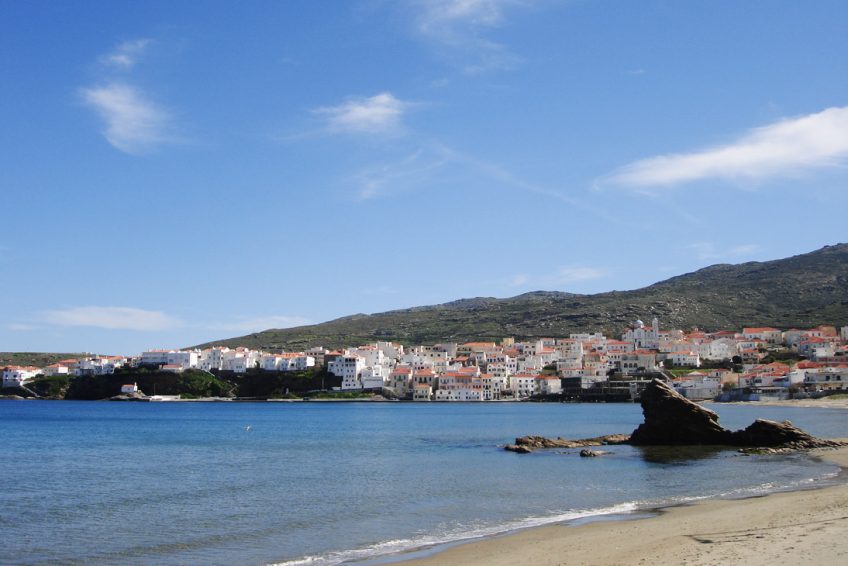
The town of Andros or Chora is the island’s capital. It is also a cultural hub in the Cyclades where numerous significant cultural events take place in the summer. It is the seat of the same-named Municipality, as well as the island’s commercial and administrative centre. The town was built on a narrow peninsula, nestled between the bays of Paraporti and Nimborio. It extends to a little islet supporting the remains of the medieval castle (Kato Kastro). The castle is connected to the mainland by a bow-shaped stone bridge known as “Kamara”.
The Chora divides in two parts: the old town, with its stone-paved, narrow alleyways and the more recent part with its impressive mansions built by wealthy ship-owners in the last century, when merchant shipping flourished. As you enter the town, you will see magnificent neo-classical buildings on either side of the marble-plated Georgiou Embirikou Street (the main street), e.g. the former residence of the Kampanis which today houses the Kaireios Library, the Vogiatzidis mansion, the Embirikeio Gymnasium, the Drakos residence where the police station is now located, the Trikoglou Residence and the building which accommodates the “Technochoros”, established by the Petros and Marika Kydoniefs Foundation.
As you make your way, the stone-plated street turns into a footpath. On your left, you will notice the two-storey building of the Andros Society-note that this is the eldest society of its kind in Greece. It has been in function since 1925, though it was founded in 1886 as a society limited to ship-owners.
Just ahead of you, you have the Gerokomeio (Retirement Home) Square. In the middle of the square you will notice the memorial of the fallen Andriots. On your right, you’ll see an impressive building that still houses the retirement home as well as the island’s health service headquarters. A bust of Andreas Embirikos stands at the entrance (on your right), facing the newly erected bust of Basil Tatakis (on the left), which was donated by the ship-owner Yiannis Karastamatis. At the left end of the square, you will see the bust of Antonios Kampanis and, to the right, those of Leonidas Karapiperis and Demetrius Paschalis. Both the retirement home and the Vocational School Building (just behind) were built through donations of the Embirikos family. The later building now houses administrative offices, with an open air cinema running in the front yard in the summer.
A little further down, you will see plenty of shops, chemists’, pastry shops, cafes, bars and banks lined up on the main shopping street. A few steps up on your right and you will find the impressive Byzantine-style Church of the Dormition of the Mother of God, whose interior features a marble iconostasis and golden adornments. The street opens to Kairis Square, where you will see a marble fountain carved by Kampanis (1818) and a bust of Theophilos Kairis.
The cafes and ouzeries on this square are usually crammed with people enjoying an ouzo or lemonade in the shade of a huge plane tree. Just behind the Kampanis fountain, you will find the entrance to the Archaeological Museum.
A flight of stairs down from the Archaeological Museum will take you to the Museum of Contemporary Art. In the summer, temporary exhibitions of international acclaim are held in the museum’s new wing, featuring significant artists such as Pablo Picasso, Giacometti, Chagall, Rodin, Toulouse Lautrec, Braque, Tetsis and more. Both the Archaeological Museum and the Museum of Contemporary Art were founded and funded by Basil and Elise Goulandris.
Further down, another flight of stairs leads to the dock of Plakoura, where you will see the little Chapel of Agia Thalassini (Our Lady of the Sea) standing on a rock in the old port, as well as a much advertised dove-cot next to the abandoned “Xenia” guest house.
Back to Kairis square: just opposite the Archaeological Museum, towards Paraporti, more stairs will take you a long way down to the Church of Our Lady Theoskepasti-the saint patron of Andros. It is worth a stop to see its magnificent iconostasis and its icons and oil lamps adorned with precious silver ex-votos.
As you walk through the arcade from Kairis Square, the Oxoporta (gateway to the old city), will lead you to the medieval part of the town with its large, well-preserved houses combining Venetian and neo-classical features. The streets are punctuated with archways, arcades and fountains.
This is the location of numerous churches, such as the Church of Our Lady Palatiani or Agia Tsoura (which has a remarkable woodcut iconostasis) and the Catholic Church of St. Andrew of the Latins. Overlooking Paraporti, you will notice the St. George’s Cathedral, which has a distinctive marble relief on the front wall and a fabulous woodcut iconostasis.
Just opposite stands Kairis’ house, where various embroidery, photography and other exhibitions take place today. Theophilos Kairis was a scholar, a philosopher, a theologian, a priest and an eminent figure of the Neohellenic Enlightenment.
The Municipal Theatre of Andros is also located a few steps from St. George’s Cathedral. The street opens into the huge Riva Square, where you’ll see an imposing statue of the Unknown Sailor by Michalis Tombros. Originally, the Embirikos family mansions also stood on the square, until 1943, when they were destroyed by German bomb raids. The square was rebuilt at the expenses of the Embirikos family.
Below Riva Square, you will see the Kamara, the tiny bridge that links the old Venetian fort to the square, and the Tourlitis lighthouse perched on a rock in the bay of Nimborio. Note that today’s lighthouse is an exact replica of the earlier one.
Back to the town’s entrance: as you head towards Nimborio, a road leads up to Vourkoti, the island’s highest village. Nimborio itself is a recent seaside resort. It is a good beach to swim and has various bars and taverns. It is protected by a breakwater to shelter private boats. Nimborio is also the base of the Andros Nautical Club, which organizes an international open sea sailing race every year.



